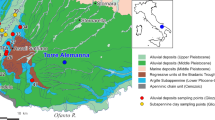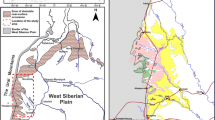Abstract
The examined dolomite is composed of 98% of mineral dolomite and 2% of calcite. Other silicates (i.e. quartz) exist only in trace amounts. This dolomite presents intense orange luminescence colour, indicating the absence of impurities and thus high purity. Its chemical composition is: CaO=32.9%, MgO=20.2%, CO2=46.7%, others=0.14% and its isotopic composition is δ18O=−3.10‰ and δ13C=+3.40‰. These values indicate that this dolomite has been formed mainly by recrystallisation of pre-existing limestone with simultaneous or subsequent partial substitution of CaCO3 by MgCO2 (dolomitisation). The data of its most important physicochemical properties are: water absorption=0.2%, water dissolution=0.17%, surface area=1.10 m2/g, pH=10.0, oil absorption=24 ml/100 g and brightness=97%. These data satisfy almost all the quality demands for use of its wastes after processing for the production of many industrial products. The most significant fields of use of the dolomite from Potamia, except its main world-wide demand as decorative stone, may be: as filler, whitening, and extender product in many paper, paint, and rubber industries; in addition, it can be used for the production of fertilisers.
Résumé
La dolomite etudiée se compose de 98% de dolomite minérale et de 2% de calcite. Les autres silicates (tel que le quartz) existent seulement en traces. Cette dolomite présente en luminescence une couleur intense orange, indiquant l'absence d'impuretés et de ce fait une grande pureté. Sa composition chimique est: CaO=32,9%, MgO=20,2%, CO2=46,7%, autres=0,14%; sa composition isotopique est: δ18O=−3,10‰ et δ13C=+3,40‰. Ces valeurs indiquent que cette dolomite a été formée surtout par recristallisation d'un calcaire pré-existant avec substitution simultanée ou substitution partielle subséquente du CaCO3 par MgCO3 (dolomitisation). Les données les plus importantes concernant les propriétés physico-chimiques sont: l'absorption de l'eau=0,2%, la dissolution de l'eau=0,17%, la surface spécifique=1,10 m2/g, le pH=10,0, l'absorption d'huile=24 ml/100 g et la brillance=97%. Ces données satisfont presque toutes les exigences de qualité quant à l'usage de ses déchets, après traitement pour la fabrication d'un certain nombre des produits industriels. Les usages les plus significatifs de la dolomite de Potamia, exception faite de sa demande universelle en tant que pierre décorative, sont les suivants: elle peut servir de filler, de produit de blanchissement ou de blanc de charge dans beaucoup d'industries (papier, peinture et caoutchouc). En plus, elle peut être utilisée pour la production d'engrais.
Similar content being viewed by others
References
Power, T., ‘Limestone specifications. Limiting constraints on the market’,Ind. Minerals 10 (1985) 65–91.
Harben, P. W., ‘The Industrial Minerals Handybook’, (Ind. Miner. Div., Metal Bull. PLC, London, 1992).
Manning, D. A. C., ‘Introduction to Industrial Minerals’, (Chapman & Hall, London, 1995).
Long, J. V. P. and Agrell, S. O., ‘The cathodoluminescence of minerals in thin sections’,Miner. Mag. 34 (1965) 318–326.
Zinkernagel, U., ‘Cathodoluminescence of quartz and its application to sandstone petrology’,Contr. Sedimentology 8 (1978).
Pierson, B. J., ‘The control of cathodoluminescence in dolomite by iron and manganese’,Sedimentology 28 (1981) 601–610.
Machel, H. G., ‘Cathodoluminescence in calcite and dolomite and its chemical interpretation’,Geoscience Canada 12 (1985) 139–147.
Herz, N. and Wenner, D., ‘Tracing the origins of marble’,Archaeology 34 (5) (1981) 14–21.
Land, L. S., ‘The isotopic and trace element geochemistry of dolomite: the state-of-the-art’, in ‘Concepts and Models of Dolomitization’, Spec. Publ.Soc. Econ. Paleont. Miner. 28 (1980) 87–110.
Land, L. S., ‘The application of stable isotopes to studies of the origin of dolomite and to problems of diagenesis of clastic sediments’, in ‘Stable Isotopes in Sedimentary Geology’,Soc. Econ. Paleont. Miner. Short Course 10 (1983) 4.1–4.22.
Laskaridis, K., ‘Appreciation of Greek white calcites and dolomite for industrial stakes (for ex. in the paper industry)’, Ph. D. Thesis, Univ. Erlangen, Nürnberg, (1987) (in German with Greek abstract).
Kaliampakos, D. and Panagopoulos, C., ‘Applicability of the dolomitic marble waste of Thassos Island as filler for limiting the relative harmful environmental impacts’,Mineral Wealth 92 (1994) 29–38.
Tsirambides, A., ‘Provenance determination of Greek white marbles by isotopic analysis of oxygen and carbon’, 2nd Symp. Hell. Archaeom. Soc., Thessaloniki, (1996) 385–394 (in Greek with English abstract).
Tsirambides, A., ‘The Hellenic marbles and other decorative stones’, (University Studio Press, Thessaloniki, 1996) (in Greek with English data).
Vavelidis, M., Eleftheriadis, G. and Kassoli-Fournaraki, A., ‘A petrological study of the crystalline complex in the Island Thassos’,Ann. Geol. Pays Hellen. 33 (2) (1988) 203–216.
Schultz, L. G., ‘Quantitative interpretation of mineralogical composition from X-ray and chemical data for the Pierre Shale’,US Geol. Surv. Prof. Paper 391-C (1964).
McCrea, J., ‘The isotopic chemistry of carbonates and a paleotemperature scale’,J. Chem. Phys. 18 (1950) 849–857.
Epstein, S., Buchsbaum, R., Lowenstam, H. and Urey, H., ‘Carbonate—water isotopic temperature scale’,Geol. Soc. Amer. Bull. 62 (1951) 417–426.
Herz, N., ‘Classical marble quarries of Thassos’, in ‘Quarrying of ancient precious and colored metals from Thassos’, extract, Vol. 5, Heidelberg (1989) 232–240 (in German).
Herz, N., ‘The oxygen and carbon isotopic data base for classical marble’, in ‘Classical marble: geochemistry, technology, trade’, (Kluwer Academic Publ. Dordrecht, 1988) 305–314.
Atzori, P., Lo Gioudice, A., Kokkinakis, A., Kyriakopoulos, K., Magganas, A., Pezzino, A., and Sideris, K., ‘Petrological and geochemical study of crystalline rocks from Thassos Island, Northern Greece’,Geol. Rhodopica 2 (1990) 157–167.
Author information
Authors and Affiliations
Additional information
Editorial Note Aristotle University of Thessaloniki is a RILEM Associate Member.
Rights and permissions
About this article
Cite this article
Tsirambides, A. Industrial applications of the dolomite from Potamia, Thassos Island, N. Aegean Sea, Greece. Mat. Struct. 34, 110–113 (2001). https://doi.org/10.1007/BF02481559
Received:
Accepted:
Issue Date:
DOI: https://doi.org/10.1007/BF02481559




